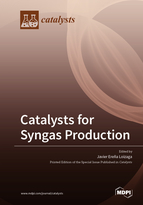Catalysts for Syngas Production
A special issue of Catalysts (ISSN 2073-4344). This special issue belongs to the section "Environmental Catalysis".
Deadline for manuscript submissions: closed (31 May 2019) | Viewed by 48250
Special Issue Editor
Interests: CO2 valorization; alternative fuels; syngas; catalysts and catalytic reactions; kinetic modeling; synthesis of methanol, dimethyl ether (DME), and hydrocarbons
Special Issues, Collections and Topics in MDPI journals
Special Issue Information
Dear Colleagues,
Synthesis gas (or syngas) is a mixture of hydrogen and carbon monoxide, with different chemical composition and H2/CO molar ratios, depending on the feedstock and production technology used. Syngas may be obtained from alternative sources to oil, such as natural gas, coal, biomass, organic wastes, etc. Syngas is a very good intermediate for the production of high value compounds at the industrial scale, such as hydrogen, methanol, liquid fuels, and a wide range of chemicals. Accordingly, efforts should be made on the co-feeding of CO2 with syngas, as an alternative for reducing greenhouse gas emissions. In addition, more syngas will be required in the near future in order to satisfy the demand for synfuels and high value chemicals.
New research for syngas production is essential for reducing operating costs, improving the thermal efficiency of the process, and preserving the environment. Advances should be made on the following aspects:
- Development of new catalysts and catalytic routes for syngas production.
- Optimization of the reaction conditions for the process.
- Use of biomass, as a promising raw material for syngas production due to its renewable character and potentially zero CO2 emission
- Steps further on catalytic processes for saving energy and capital cost, and for optimizing the quality and properties of syngas, such as H2/CO molar ratio and absence of contaminants.
Dr. Javier Ereña
Guest Editor
Manuscript Submission Information
Manuscripts should be submitted online at www.mdpi.com by registering and logging in to this website. Once you are registered, click here to go to the submission form. Manuscripts can be submitted until the deadline. All submissions that pass pre-check are peer-reviewed. Accepted papers will be published continuously in the journal (as soon as accepted) and will be listed together on the special issue website. Research articles, review articles as well as short communications are invited. For planned papers, a title and short abstract (about 100 words) can be sent to the Editorial Office for announcement on this website.
Submitted manuscripts should not have been published previously, nor be under consideration for publication elsewhere (except conference proceedings papers). All manuscripts are thoroughly refereed through a single-blind peer-review process. A guide for authors and other relevant information for submission of manuscripts is available on the Instructions for Authors page. Catalysts is an international peer-reviewed open access monthly journal published by MDPI.
Please visit the Instructions for Authors page before submitting a manuscript. The Article Processing Charge (APC) for publication in this open access journal is 2700 CHF (Swiss Francs). Submitted papers should be well formatted and use good English. Authors may use MDPI's English editing service prior to publication or during author revisions.
Keywords
- Catalytic processes for synthesis gas production
- Syngas
- Hydrogen
- CO2
- Water gas shift reaction
- Natural gas
- Coal
- Biomass
- Reforming
- Partial oxidation
- Gasification






